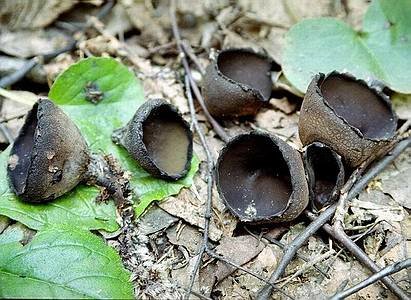Urnula goblet (Urnula craterium)
- Department: Ascomycota (Ascomycetes)
- Subdivision: Pezizomycotina (Pezizomycotins)
- Class: Pezizomycetes (Pezizomycetes)
- Subclass: Pezizomycetidae (Pezizomycetes)
- Order: Pezizales (Pezizales)
- Family: Sarcosomataceae (Sarcosomes)
- Genus: Urnula (Urnula)
- Type: Urnula craterium (Urnula goblet)

Author of the photo: Yuri Semenov
Hat: a hat 2-6 cm in diameter has the shape of a glass or urn on a short false leg. In youth, the fruiting body is closed, in the shape of an egg, but soon it opens, forming torn edges, which are leveled as the fungus matures. The inside is dark brown, almost black. Outside, the surface of the urnula mushroom is slightly lighter.
Pulp: dry, leathery, very dense. Urnula does not have a pronounced smell.
Spore powder: brown.
Spread: Urnula goblet occurs from late April to mid-May in various forests, but most often on the remains of deciduous trees, in particular, submerged in the soil. As a rule, it grows in large groups.
Similarity: Urnula goblet cannot be confused with any other common type of mushroom, thanks to the large fruiting bodies growing in the spring.
Edibility: nothing is known about the edibility of the urnula mushroom, but most likely you should not eat it.
Urnula goblet appears only in spring and bears fruit for a very short time. Due to the dark color, the fungus merges with the darkened leaves, and it is quite difficult to detect it. The British called this mushroom “devil’s urn”.
Video about the mushroom Urnula goblet:









